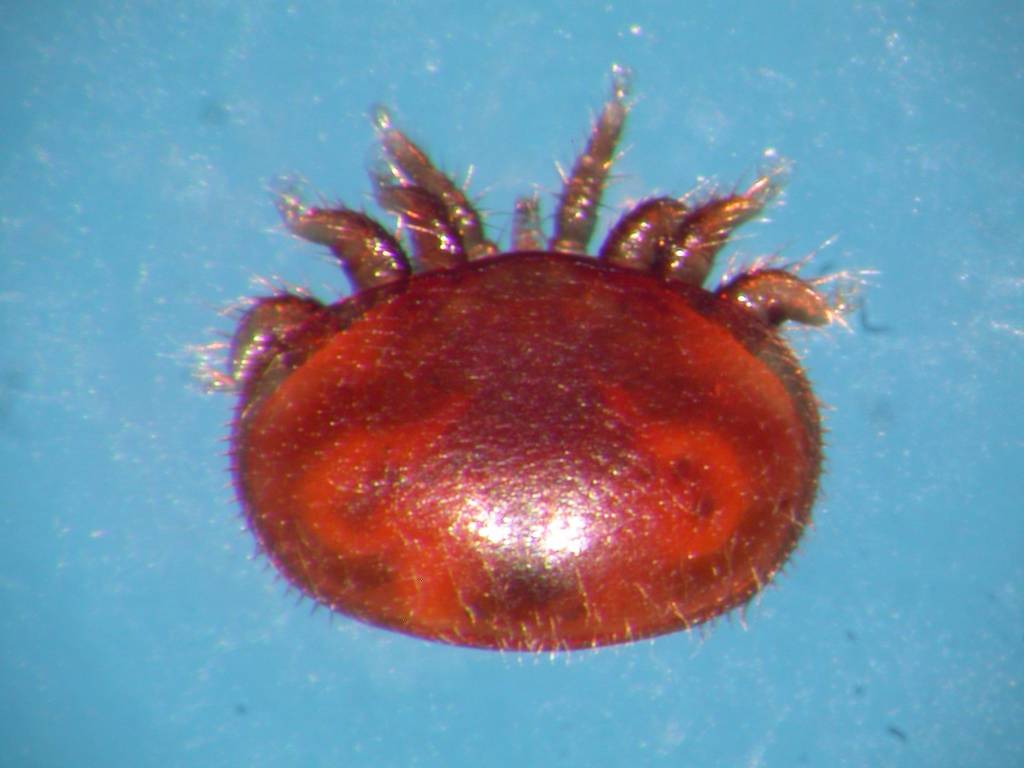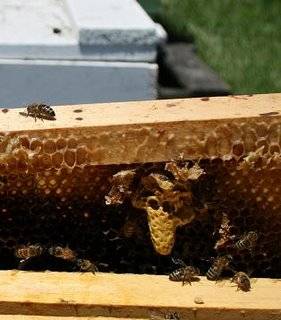 For those arriving via a uncensored google image search, my apologies for cluttering your results. The creature to the left is female, but unfortunately her very existence threatens much of what you eat. One-third of the human diet is derived from insect-pollinated plants, and the honey bee is responsible for about 80 percent of their pollination. The varroa mite (whose latin name Varroa destructor would likely win it the “species most likely to become a summer movie title” award), is steadily destroying honeybee colonies the world over, and one of the most promising efforts for surviving this onslaught is through the breeding of queens with the right genes (even more image search fodder!). That’s happening right here in East Central Illinois.
For those arriving via a uncensored google image search, my apologies for cluttering your results. The creature to the left is female, but unfortunately her very existence threatens much of what you eat. One-third of the human diet is derived from insect-pollinated plants, and the honey bee is responsible for about 80 percent of their pollination. The varroa mite (whose latin name Varroa destructor would likely win it the “species most likely to become a summer movie title” award), is steadily destroying honeybee colonies the world over, and one of the most promising efforts for surviving this onslaught is through the breeding of queens with the right genes (even more image search fodder!). That’s happening right here in East Central Illinois.
This weekend I attended the 2009 annual meeting of the Central Eastern Illinois Beekeepers’ Association, of which I’m a proud (if very inexperienced) member. This group has been in existence since the early sixties, and at our meetings you’ll find the most knowledgeable people on Apis mellifera (no movie titles for the poor honeybee) for hundreds of miles around. You’ll also find a lot of folks that grow vegetables, raise cows, pigs, and horses, fix their own tractors, and live in a dozen or so tiny towns in our area, often on several acres of land handed down. Most arrive in large trucks. I’m the weird guy who keeps bees in the city and who rode his bicycle to the meeting. (Given the temperature, some would substitute other words for “weird.”) Nevertheless, I was greeted with smiles and handshakes, and directed to the table of available sweets. I wrote my $16 check for annual dues, and sat down to hear our speaker, Dr. Stu Jacobson from the U of I Springfield.
Honeybees are perhaps the most complex and beautiful creatures one can encounter, and I’m not going to even scratch the surface of bee behavior with this post. Understanding bees and becoming a successful beekeeper are lifelong pursuits (my favorite kind), and the challenges of maintaining a healthy hive have grown dramatically over the past three decades. Since the late eighties, the number one threat has been the varroa mite.
Varroa mites infest a hive rapidly, laying eggs inside capped brood (baby bee) cells on bee larvae. The young mites hatch at the same time as the young bee, leaving the cell with it to spread throughout the hive. They suck the blood of adult bees, weakening their immune systems, and leading to infection and death. Treatment by chemical means (miticides) has been sporadically successful, but the mites have rapidly developed resistance to each of these chemicals. The presence of the miticides themselves can also weaken the bees; many suspect buildup of varroa treatments as a contributing factor in the recent emergence of “Colony Collapse Disorder (CCD),” which has thankfully not (yet) arrived in Illinois. In addition, there is not a clear understanding of the risk posed to humans from the presence of these toxins in the honey that is produced in treated hives.
Luckily, there are alternate ways to approach the problem. Several lines of honeybees have been developed for their “hygenic” nature: their ability to detect infected brood before it hatches, and to remove such brood from the hive. While a colony raised from a hygenic queen will still be at risk from varroa, this risk is much reduced. The pioneering work in this field was done by Marla Spivak & Gary Reuter at the University of Minnesota, and has resulted in the “Minnesota Hygenic” line. Other lines have also been developed, and there are now several to choose from, and a multitude of sources selling them. The focus of Dr. Jacobsen’s talk was on how to choose, purchase, and breed queens from the various lines.
 Breeding queens! For someone like me, with two hives and two kids in middle school, breeding queens is not yet on the to-do list. Luckily, our club president, David Burns of Long Lane Honey Bee Farm in Fairmount is leading the way, as part of the nascent Illinois Queens project, an effort to develop local stock of honeybee queens which are adapted to our climate and local pathogens. He’s actively raising hygenic queens for sale, and he’s also tirelessly teaching classes and blogging on how to keep bees, from beginning steps through queen rearing itself.
Breeding queens! For someone like me, with two hives and two kids in middle school, breeding queens is not yet on the to-do list. Luckily, our club president, David Burns of Long Lane Honey Bee Farm in Fairmount is leading the way, as part of the nascent Illinois Queens project, an effort to develop local stock of honeybee queens which are adapted to our climate and local pathogens. He’s actively raising hygenic queens for sale, and he’s also tirelessly teaching classes and blogging on how to keep bees, from beginning steps through queen rearing itself.
The CEIBA club also teaches a beginning beekeeping class at the Anita Purves Nature Center, running every Thursday night for six weeks starting February 26. This is a great way to get everything you need to keep bees, from the equipment (which members of the club will build, paint, and sell you) to the bees (see above), and most importantly the know-how to do it. I learned so much from that class the first time I took it that I re-enrolled the following year. The folks that teach it do so as a volunteer service to the community, and to increase the number of hives being kept. (The fee for the class just pays for the books that you take home and the rental of the classroom.)
Apart from the taste of fresh honey from the comb (which words cannot describe), taking part in this group has furthered my understanding of the meaning of local food, community, and sustainability, and my next article for Smile Politely will try to touch on how these themes are interwoven. Until then, I’ll be waiting for the first 50 degree day to see how my bees have fared this bitter weather, and trying to avoid injecting bee-related puns into my writings.
Y’all bee careful out there.








